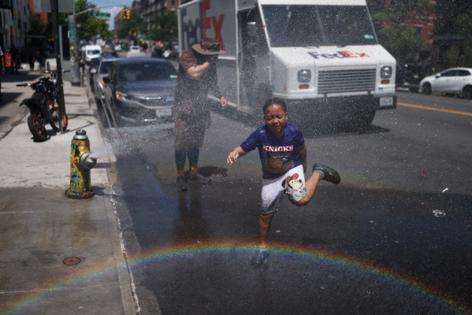Ask the Pediatrician: Preventing heat-related illness in children as temperatures rise
Published in Health & Fitness
The arrival of summer should mean more outdoor playtime for children, but the lessons of last summer warn of a different experience. As pediatricians, we see that as climate change leads to higher temperatures each year and longer stretches of hot days, parents increasingly need to be aware of the risks of heat-related illness on children.
If you feel hot, your kids are likely feeling hotter. In pediatrics, our mantra emphasizes that kids are not little adults. It is critical to recognize the unique vulnerabilities of children during periods of elevated temperatures.
There are innate differences in how children respond to heat compared to adults. Babies and small children have more body surface area than mass, so they gain heat quickly, up to 3-5 times faster than an adult. Babies are particularly vulnerable as they are still developing their sweat glands and thermoregulatory systems. While they do sweat, it is not as efficient at cooling them off. In addition, infants cannot modify their behaviors to cool down or tell us that they are overheating. They are reliant on their caregivers to recognize the signs of heat-related illness and offer relief.
The early signs of overheating in infants and young children include sweating, facial flushing or feeling warm to touch. Later signs could include faster breathing, muscle aches or cramps, vomiting, confusion, a feeling of faintness, headache, and pale or clammy skin. Some of the more subtle signs include tiredness or listlessness, irritability and decreased urination. Monitoring for and recognizing these symptoms requires a caregiver to watch their infant or child closely.
To mitigate the impacts of heat, some parents create tents with blankets or sun shields draped over car seats, strollers or beach chairs. While these may provide some protection from the glare of the sun, they can also trap heat and limit ventilation. Importantly, they can obstruct views of the child and prevent close monitoring, and therefore may increase the risk of overheating.
Older children may be at risk for exertional heat stroke while increasing physical activity during recess or sports training. Children have a faster metabolic rate and generate more heat during exercise. Furthermore, children take longer to acclimate to exercise in the heat. The American Academy of Pediatrics has guidelines for coaches, athletic trainers and others on prevention of heat-related illness, including acclimatization, gear limits and hydration, as well as the management of athletes who demonstrate signs of overheating.
One of the greatest risks to children during the extreme heat is hot cars, which is why many states have laws against leaving children unattended in cars. Vehicular heat stroke kills dozens of children each year in the United States, often after either being left alone in the car or playing in the car and becoming trapped. Well intentioned parents may leave a sleeping child in the car with the window cracked. However, temperatures in cars can rise up to 20 degrees in 10 minutes. In the time it takes to get a latte on an 85 degree day, a child could be at 105 degrees, which is hot enough to cause organ failure.
Many parents ask, “How hot is too hot for children to go outside?” While temperatures above 90 degrees Fahrenheit may pose risk of heat-related illness, it is critical to account for the heat index and humidity, duration of time outdoors, types of activities and cooling strategies. Staying in shaded areas, using a cool mist and fan, keeping hydrated, and wearing light colored and loose-fitting clothing can all help keep a child cooler. On extremely hot days, fans are not enough and when temperatures are above 90 degrees, they can even make you gain heat. Air conditioning has been shown to be protective, so identifying accessible air-conditioned buildings and taking breaks from the heat is important.
As parents work to protect their kids from rising temperatures every day, we know broader systematic support is needed. The Early Childhood Scientific Council on Equity and the Environment at The Center on the Developing Child at Harvard University released a working paper titled "Extreme Heat Affects Early Childhood Development and Health," in which they outline a framework to identify root causes and look at both short-term and long-term community-led solutions. We need infrastructure and community engagement solutions like school partnerships, heat resilient urban planning, expanded greening, affordable cooling options and more to address climate change related impacts on child health. As the earth’s temperature increases, we need to increase our efforts to keep our children safe.
____
Harleen Marwah, MD, MS, is a pediatrician with over 10 years of experience in the climate-health space. She was the founding Chair of Medical Students for a Sustainable Future, has developed climate-health curricula to equip training clinicians to care for patients in the context of climate change, and served on the Biden-administration White House Environmental Justice Advisory Council.
Katie Lockwood, MD, MEd, is a pediatrician at Children's Hospital of Philadelphia and a spokesperson for the American Academy of Pediatrics. She is the host of Primary Care Perspectives podcast and is passionate about medical education.
©2025 Tribune Content Agency, LLC.










Comments